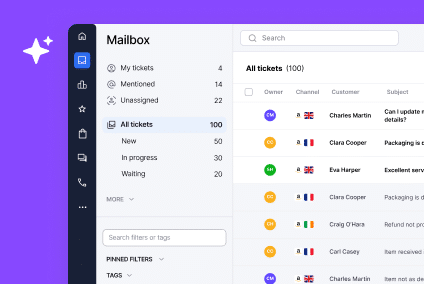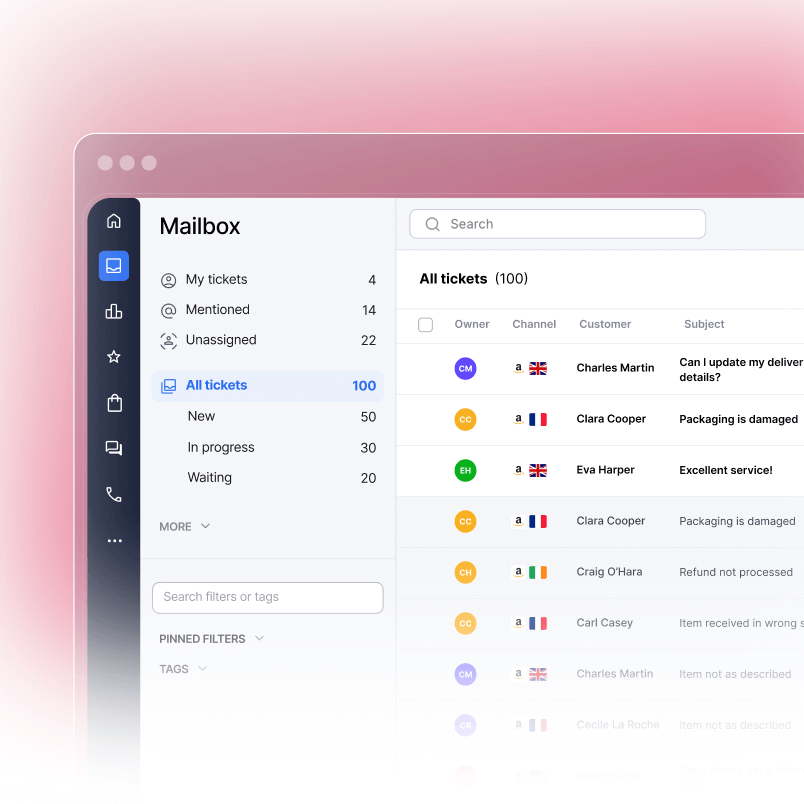eCommerce customer support is evolving faster than ever. In 2025, the brands winning are the ones moving beyond reactive support. They’re using AI to predict problems before customers call. They’re routing conversations based on urgency and skill level. They’re turning post-purchase moments into loyalty drivers. If your support strategy hasn’t changed since 2023, you’re already behind. This trend report breaks down 15 critical shifts reshaping eCommerce CX, with tactical advice and tools your team can implement right now.
Why Staying Ahead of CX Trends Matters
Support is no longer a cost center. It’s a revenue driver. Brands that treat it that way are seeing measurable growth. According to a 2024 study, 80% of customers would pay more for better support. That’s not passive loyalty; that’s willingness to spend money. When your team handles problems well, customers buy again. When they don’t, you lose them to competitors.
Falling behind CX trends has real consequences. Churn accelerates. Review scores drop. Negative feedback spreads online faster than ever. Meanwhile, you’re spending more time on repetitive issues that automation could solve in seconds. The brands adapting fastest are retaining customers at higher rates, scaling without hiring proportionally, and staying profitable.
The winners in 2025 share a common trait: they’ve automated tier-1 support, freed agents to handle complex cases, and built systems that feel personal even at scale. When support becomes a strategic function, revenue follows. Learn how customer retention strategies connect directly to your bottom line.
AI-Powered Copilots for Agents
How AI Copilots Transform Agent Productivity
AI works alongside agents in real time, suggesting responses, flagging urgent tickets, and pulling relevant customer history instantly. Agents spend 40% of their day searching for information or composing responses from scratch. A good copilot cuts that time in half. Response quality improves. Consistency across your team becomes automatic. Fewer missed details mean fewer escalations. Discover how AI transforms day-to-day support operations and improves team efficiency through advanced CX software.
Start with an AI copilot integrated into your helpdesk. Look for tools that surface customer history, past issues, and recommended solutions in one view. Train your team to use suggestions as starting points, not final answers. Set KPIs around time-to-response and customer satisfaction.
Predictive Support Before the Customer Asks
Detecting Issues Before They Escalate
AI analyzes customer behavior, order history, and product attributes to flag issues before they become complaints. A delayed shipment detected early means proactive outreach. A product known for specific issues gets a targeted support message. Customers feel heard before they have to complain. Your support volume drops because problems resolve before they escalate. Returns decrease. Net Promoter Score increases. You shift from reactive firefighting to strategic prevention. This approach to AI-powered support reduces churn and builds lasting customer loyalty.
Identify your top 5 recurring customer issues. Map the warning signs that precede each one. Feed that data into your platform’s AI system. Start with one predictive workflow and measure impact over 60 days. If it works, expand to other issue types.
Channel Consolidation Into Unified Inboxes
Centralizing Customer Conversations Across All Channels
All customer conversations across email, chat, social media, marketplace messages, and SMS funnel into one inbox. Agents work from one view instead of toggling between five different apps. You spend less time switching contexts. Customers get faster replies because your best agent sees their message immediately, regardless of channel. Nothing falls through cracks. Your team works at peak efficiency. A unified approach to support management through a best eCommerce helpdesk eliminates silos and improves response times.
Audit every channel where customers reach you today. Prioritize consolidation by volume. Start with the top three channels. Implement a unified inbox platform that handles routing and gives agents full conversation history. Set a standard response time and track adherence.
24/7 Support With Global Agent Networks and Automation
Always-On Support Across Time Zones
Combine time-zone coverage, automation for off-hours, and AI chatbots that handle tier-1 issues while humans sleep. Customers always get an immediate response. Research indicates 38% of eCommerce customers expect 24/7 support availability. Brands offering it see higher conversion and retention. You don’t need a 24/7 in-house team. A mix of offshore agents, local coverage, and solid automation handles it affordably. Automation during off-hours keeps costs down while maintaining responsiveness through time-saving customer service automation.
Map your customer timezone distribution. Identify the off-hours gaps. Deploy an AI chatbot to handle FAQs, order tracking, and return initiation during those hours. Consider a fractional team in a complementary timezone. Measure how many issues resolve without human touch. Adjust automation confidence levels based on results.
AI-Powered Self-Service Search and Product Instructions
Intelligent Search That Understands Customer Questions
Instead of generic FAQs, AI powers a search engine that understands questions in natural language. Customers type “how long does delivery take” and get their specific answer based on their order, location, and carrier. Studies show 70% of customers prefer self-service when it works. When implemented correctly, self-service reduces support volume by 20-30%. You scale without hiring. Customers get instant answers at 2 AM without waiting for an agent. An AI chatbot for eCommerce can handle the majority of these self-service interactions.
Audit your current self-service content. Expand your knowledge base to cover 80% of recurring questions. Use AI to index and make it searchable across product pages, checkouts, and your help center. Test with internal team first. Launch with a prominent search widget.
Proactive Chat on Product Pages and Checkout
Meeting Customers at High-Intent Moments
Chat windows appear on product pages and checkout pages at strategic moments. An AI or agent offers help just as customers are about to bounce or make a decision. The moment before purchase is the highest-value moment to influence a buyer. Proactive chat reduces cart abandonment by 10-15% on average. It also catches product concerns before checkout, increasing average order value and reducing returns. This trend drives both revenue growth and customer satisfaction simultaneously, and best live chat for eCommerce platforms make this easy to implement.
Identify pages with high bounce or abandonment rates. Add a proactive chat trigger on those pages with one specific offer or question. Start with product pages. Measure conversion lift over 30 days. Optimize message copy based on performance. Expand to checkout if results are positive.
Multilingual Support via Neural Translation
Breaking Language Barriers With AI
AI translates customer messages in real time, allowing agents to serve customers in any language without being fluent. Translation quality has improved dramatically in 2024-2025. You tap new markets without hiring multilingual agents. Support becomes a global service. Customer satisfaction doesn’t drop even when language differences exist. Response times stay fast. Accurate AI translation software now enables eCommerce teams to serve global audiences efficiently.
Identify the top 3-5 languages your customers speak. Test a neural translation platform with a subset of your team. Start with one language pair. Measure accuracy and customer satisfaction over 60 days. Build confidence before rolling out wider. Always allow customers to request a native speaker for sensitive cases.
Smart Routing Based on Intent and Urgency
Sending Tickets to the Right Expert, Right Away
Tickets are assigned based on customer intent (billing issue, product question, return request) and urgency (shipping out tomorrow, general inquiry). The right ticket goes to the right specialist in seconds. Specialists handle cases in their area. Resolution time drops. First-contact resolution improves. Customers don’t get transferred repeatedly. Your team efficiency increases 20-30% just from better routing. An SLA tracking system helps monitor performance across these smart routing workflows.
Define 4-6 ticket categories. For each, assign the specialist or team most qualified to handle it. Create urgency rules that bump high-priority tickets to the front. Set up automated routing based on keywords, customer history, or customer value. Monitor first-contact resolution monthly.
Marketplace-Compliant Messaging Standards
Staying Compliant Across Amazon, eBay, Walmart, and Beyond
Amazon, eBay, Walmart, and other marketplaces have strict rules about what you can and cannot say in buyer-seller messaging. Platforms built for eCommerce enforce these rules automatically. Compliance violations result in account suspensions. Lost marketplace visibility means lost sales. A messaging platform designed for marketplaces prevents violations before they happen, keeping your account in good standing and your revenue stream protected.
If you sell on multiple marketplaces, audit your current messaging tool. Confirm it enforces compliance for all platforms you use. Review your team’s messaging templates to ensure no violations. Use a unified messaging platform that removes compliance risk from human error. Learn more about managing communications across Amazon buyer-seller messaging and other marketplace platforms.
Revenue Attribution to CX Touchpoints
Connecting Support Interactions to Sales and Revenue
Your platform tracks which customer service interactions led directly to sales, retention, or upsell. A customer service email that results in a reorder gets tracked. So does a proactive chat that prevented a return. You stop treating support as a cost center. You see exactly how support drives revenue. You can justify budget for support tools and staffing using concrete ROI. Leadership alignment improves because support is now a business metric. Understanding customer experience metrics helps align your team around these revenue-driving KPIs.
Select one customer journey to track: first-time buyer, repeat buyer, or high-value customer. Tag support interactions related to that journey. Feed those tags into your analytics. Compare revenue per customer based on support quality metrics. Present findings to leadership monthly.
Invisible Support for Post-Purchase Experiences
Proactive Communication That Feels Effortless
Automated workflows handle common post-purchase needs without customer contact. Shipping delays trigger proactive email updates. Return instructions send automatically. Delivery confirmations arrive at the right moment. Customers feel supported without having to ask. You reduce support tickets by 15-20% just by automating routine communication. Customers feel cared for. Returns process friction decreases. You maintain satisfaction scores while reducing workload. Automation is a key pillar of successful customer service strategies.
List 10 post-purchase moments where customers commonly contact support. For each, build an automated workflow that proactively addresses the need. Test one workflow. Measure support ticket reduction and customer satisfaction impact. Scale to others based on results.
Returns Automation With Embedded Support
Turning Returns Into Loyalty Moments
The returns process is built into your support system. Customers can initiate a return directly from a chat or email. They receive return shipping labels automatically. Support can track return status and proactively update customers. Returns are a major support cost and customer pain point. When automated, they feel frictionless. Customers appreciate ease. Your team spends less time on return logistics. Return rate perception improves because the process is transparent and fast. Implementing returns automation reduces friction and keeps customers satisfied even when they need to return an item.
Map your current returns process end-to-end. Identify steps that should be automated and which require human touch. Implement a returns automation feature in your helpdesk or eCommerce platform. Test with a small group. Measure time-to-resolution and customer satisfaction. Expand based on results.
Omnichannel Support Beyond Traditional Platforms
Meeting Customers Where They Already Are
Customers can reach you via WhatsApp, TikTok DM, Instagram, SMS, and other emerging channels. Your support system ingests all of them into one view. Your customers are already on these platforms. Meeting them there increases engagement. Younger demographics especially expect support on social channels. You’re not asking them to use your preferred channel; you’re meeting them on theirs. WhatsApp for eCommerce support is particularly valuable for reaching global audiences.
Identify which new channels your audience uses most. Start with 1-2 (WhatsApp and SMS are good first choices). Connect them to your helpdesk. Train your team. Measure response times and satisfaction. Add additional channels as team confidence grows.
Sentiment Analysis for Ticket Prioritization
Prioritizing Frustrated Customers Automatically
AI analyzes customer tone and emotion in incoming messages. Frustrated customers get bumped to the front of the queue. Happy or neutral inquiries stay in normal rotation. You de-escalate problems faster. Customers with minor concerns wait slightly longer, but customers at risk of churn get immediate attention. Your team handles the highest-emotion cases when agents are freshest. Overall satisfaction improves. This approach to customer feedback analysis ensures your team focuses on the customers who need help most.
Enable sentiment analysis in your platform. Set rules that push high-sentiment tickets to the front of queue. Monitor over 30 days for false positives. Refine rules based on your unique customer base. Measure change in satisfaction scores before and after.
First-Contact Resolution as a Core KPI
Measuring What Really Drives Customer Loyalty
Instead of just tracking resolution time, you measure what percentage of issues are resolved on first contact. This becomes a core performance metric for individuals and teams. FCR drives customer loyalty more than any other metric. Customers who reach resolution on first contact are 2-3 times more likely to repurchase. One-and-done interactions feel efficient and professional. Your team morale improves when they see tangible impact. Explore how customer retention strategies show that FCR directly impacts lifetime value.
Calculate your current FCR rate. Set a target 5% higher than baseline. Train your team on handling edge cases that often require transfers. Implement a feedback system where customers confirm resolution on first contact. Track weekly and celebrate wins. Adjust processes based on common failure points.
Final Summary
The support landscape is shifting from reactive to proactive, from manual to automated, and from channel-specific to omnichannel. The 15 trends above are not optional in 2025. They’re table stakes for brands competing for customer loyalty and lifetime value.
Support teams that embrace automation and AI will outperform those relying on manual processes. Brands that consolidate channels and prioritize first-contact resolution build lasting customer relationships that drive repeat sales and reduce churn.
Start with one or two trends that address your biggest pain points. Implement, measure, and improve. As your confidence grows, layer in additional trends. By the end of 2025, your support operation will look fundamentally different. More efficient. More human. More profitable.
Your customers will notice the difference before your competitors do. That difference translates to loyalty, word-of-mouth growth, and sustainable revenue.
Begin today by auditing your current support stack. Which of these 15 trends are you already using? Which should be your first move? Pick one trend, set a 30-day implementation plan, and get started. Consider how advanced eCommerce support software and best customer support tools can accelerate your progress.
Ready to Transform Your Support Operation
eDesk brings all 15 of these trends into one unified platform. AI copilots, predictive support, omnichannel messaging, sentiment analysis, and automated returns all work together to reduce your workload while improving customer satisfaction. You’ll consolidate your entire support stack, eliminate manual work, and prove ROI to leadership in weeks, not months.
Start implementing these trends immediately. Sign up for eDesk free today and see how unified omnichannel support transforms your customer retention and scales your business without proportional hiring.
FAQs
What is the biggest eCommerce customer support trend in 2025?
AI copilots and predictive support are the biggest shifts. They move support from reactive problem-solving to proactive prevention. This fundamentally changes how support teams work and what customers experience.
How is AI changing eCommerce customer service?
AI is automating tier-1 issues, suggesting responses to agents, predicting problems before they happen, and routing tickets intelligently. This frees your human team to handle complex, high-touch cases that need nuance and empathy.
What KPIs should support teams focus on in 2025?
First-contact resolution, customer satisfaction score, revenue attribution, ticket resolution time, and sentiment-based queue management. Choose 3-4 that align with your business goals and track them weekly.
Which tools are best for modern eCommerce support?
For unified eCommerce support, look at platforms like eDesk that integrate email, chat, social, and marketplace messaging in one system. Pair that with AI-powered automation tools. Build a stack that fits your specific channels and volume.
What’s the difference between reactive and proactive support?
Reactive support waits for customers to contact you. Proactive support detects problems and reaches out first. Proactive support prevents churn, reduces ticket volume, and improves satisfaction.
How quickly should I implement these trends?
Start with automation and unified inbox foundations. These give you the biggest immediate ROI. Add AI and predictive layers over the next 3-6 months. Don’t try to implement all 15 at once.
Should I hire more support staff in 2025?
Probably not. Instead of hiring, implement the trends in this guide. AI copilots, automation, and smart routing let existing teams handle 30-50% more volume without burnout. Hire only if volume grows significantly after optimization.
Is omnichannel support necessary for small eCommerce businesses?
Start with the 2-3 channels where your customers are most active. Expand slowly. A focused omnichannel approach is better than spreading thin across 10 channels.




